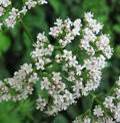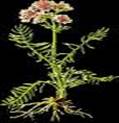Scientific Classification:
|
Other Common Names:
The other common names for the herb valerian are Blessed Herb, Capon's Tail, English Valerian, Garden Heliotrope, German Valerian, Great Wild Valerian, Heliotrope, Setwall, Tagara, Valerian, Vandalroot and Vermont Valerian.
History


Description



Range
The plant is found throughout Europe and Northern Asia, and is common in England Two species of Valerian, Valeriana officinalis and V. dioica, are indigenous in Britain, while a third, V. pyrenaica, is naturalized in some parts. The genus comprises about 150 species, which are widely distributed in the temperate parts of the world.Habitat
This herb thrives best in marshy thickets and on the borders of ditches and rivers. valerian grows wild in damp conditions. Valerian does well in all ordinary soils, but prefers rich, heavy loam, well supplied with moisture.Cultivation
The wild plants are collected from local woods and transplanted to the prepared land. Generally the young flowering plants given off by the perennial rhizomes of old plants which develop towards the close of summer are given preference. These should be set 1 foot apart in rows, 2 or 3 feet apart. The soil should first be treated with farmyard manure, and after planting it is well to give liquid manure from time to time, as well as plenty of water. The soil must be well manured to secure a good crop. Weeding requires considerable attention.Propagation may also be by seed, either sown when ripe in cold frames, or in March in gentle heat, or in the open in April. In the first two cases, transplant in May to permanent quarters. But to ensure the best alkaloidal percentage, it is best to transplant and cultivate the daughter plants of the wild Valerian. The flowering tops must be cut off as they appear, thus enabling the better development of the rhizome. Many of the young plants do not flower in the first year, but produce a luxuriant crop of leaves, and yield rhizome of good quality in the autumn.
Flowering Season
The flowers of the valerian are in full bloom in late spring.Pests and Diseases
Valerian succumbed to disease that is exacerbated by moisture and mulch retains too much water.Rarely it is been affected by plant feeding insects and mites.Parts Used
 | The roots and rhizome are the most commonly used part of the valerian herb. |
Medicinal and Commercial Applications

- It is excellent for headaches, trembling, palpitations, hysteric complaints and the vapours.
- It is used by Eastern nations to aromatize their baths.
- It is used in treating cramps.
- Valerian is a powerful nervine, stimulant, carminative and antispasmodic.
- It has a remarkable influence on the cerebro-spinal system, and is used as a sedative. The drug allays pain and promotes sleep. It is of especial use and benefit to those suffering from nervous overstrains.
- Oil of Valerian is employed to a considerable extent on the Continent as a popular remedy for cholera, in the form of cholera drops, and also to a certain extent in soap perfumery.
- Valerian helps in strengthening the eyesight, by giving energy to the optic nerve.
- It is used as an anti-convulsant in epilepsy.
- Valerian has been used in the treatment of cardiac palpitations.
- Valerian is beneficial for almost any stress-related condition, and, in general, has a calming, rather than directly sedative, effect on the mind.
- Many symptoms of anxiety, including tremors, panic, palpitations, and sweating, can be relieved with valerian.
- Valerian relaxes over contracted muscles, and is helpful for shoulder and neck tension, asthma, colic, irritable bowel syndrome, muscle spasms, and menstrual pain.
Folklore and Myths
'Men who begin to fight and when you wish to stop them, give to them the juice of Amantilla id est Valeriana and peace will be made immediately. Valerian is sedative to humans, but excites both cats and mice. In the legend of the Pied Piper of Hamlin, he baited the rodents with valerian to drive them out of the city. The flowers are used in charm bags to encourage love, protection and sleep.

